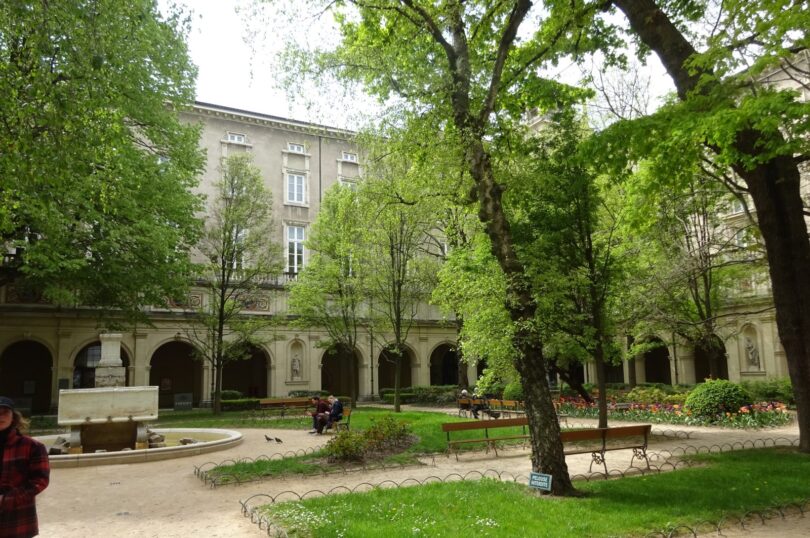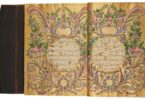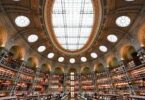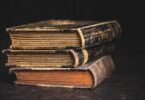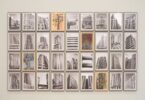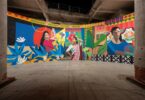A. Peter Dore
Delve into the captivating depths of Lyon’s Museum of Fine Arts and immerse yourself in the captivating fusion of history and artistry showcased through the enigmatic Luristan bronzes
The location of the French city of Lyon at the junction of two great rivers, the Rhone and the Saone, explains the importance this city has played in French history, and this, in turn, is reflected in its wealth of impressive buildings spanning the centuries. These include a grand Roman theater, the 17th-century Hotel de Ville, as well as the Basilica of Notre-Dame of Fourviere, a Byzantine-inspired basilica ornately decorated in part in Art Nouveau style. The Museum of Fine Arts (Musee des Beaux-Arts) is also housed in one of the fine old buildings of Lyon, a former Benedictine abbey. Much like the architecture of the city itself, the artifacts in this museum span many eras, and indeed the rich collection of the museum is greater than any other in France save for the Louvre. One of the major draws to the museum for me was its collection of Luristan bronzes. I had recently read about them in a book on ancient Iranian history by the esteemed Iranologist R. Ghirshman. So on my visit to the museum, I soon found myself in the corridor exhibiting Near Eastern artifacts.
Luristan bronzes
The Luristan bronzes originate as tomb goods from tombs across northern Luristan in Iran. The items first received wide recognition in the early part of the 20th century, becoming particularly popular at that time with private collectors in the West. They put Luristan on the map in such a way that inspired Freya Stark to visit the area, leading to her becoming a travel writer. Indeed, in her debut 1934 book “The Valleys of the Assassins and Other Persian Travels,” she notes that “the whole of Europe is now flooded with antiques from Luristan” though she also archly adds in parenthesis that “many of them (are) fakes.” The Luristan bronzes also found their way into museums like the one in Lyon.
The Luristan bronzes, dating to the early part of the first millennium B.C., belong to the late Bronze Age and, as such, are to some extent related to the bronze items belonging to that and the earlier divisions of the Bronze Age found in museums across Anatolia, and especially in the Museum of Anatolian Civilizations. Nevertheless, in another sense, they are unique. That is why, in his book, Ghirshman notes that, “Civilizations such as that of the people who made the Luristan bronzes and created something which was entirely new to the country are of rare occurrence.”
As for the Luristan bronzes on display in Lyon, in one sense, they are similar to the items I had already seen in Batman Museum earlier in the year in that they mainly serve a practical purpose but are artistically rendered. The item that particularly stood out for me is the handle of a knife sharpener.
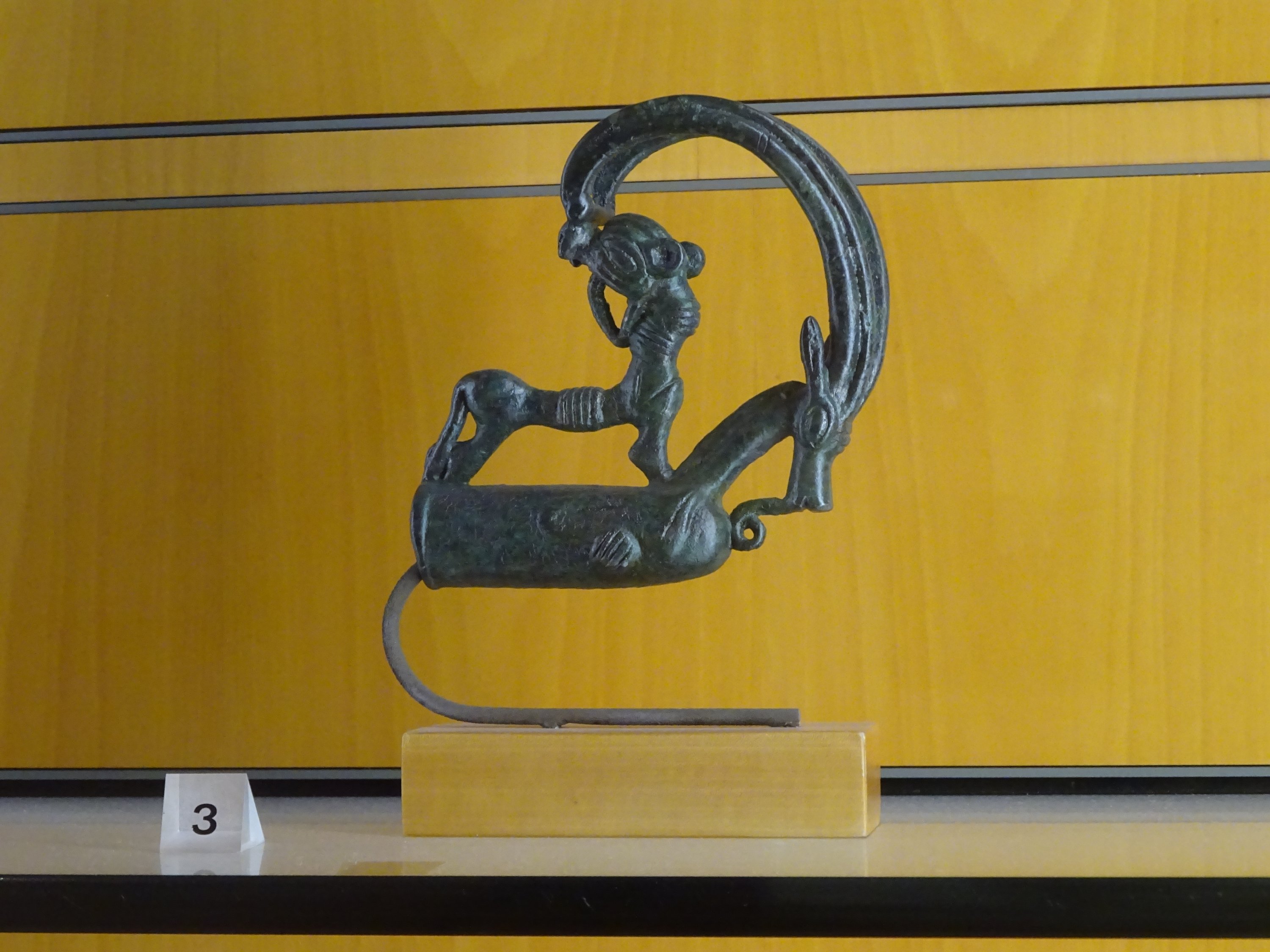
It is of a four-legged creature atop what must be, owing to its huge curved horns and its long beard, a stylized ibex, perhaps a Siberian one. The creature that is atop the other is fantastical, though, being centaur-like with its four animal legs and what appears to be the heavy tail of a horse, but with an upper part that seems to be the torso of a biped. While this part clearly has a chest and a midriff, it hardly looks human, as what must be its head is marked by circular ears ahead of what appears to be a massive tilted eye adjoined to the enormous curved horns of the beast it is riding. As for the ibex below, it is this that is particularly arresting. This sleek, simple beast would not look out of place next to a modern one by Jacques Lipchitz or Constantin Brancuşi. The Brancuşi element is especially evident in the oversized oval of its eye. The huge curve of the horns frames the whole piece, whereas below, its beauty in simplicity continues with the graceful neck that attaches the head to the cylindrical body.

Nearby, there are two horse bits on display. Yet, they are radically different from one another. One is decorated with figures, while the other takes a minimalist approach. On the trimmed bit, the figures have that cartoonish look that may be found in certain ancient Near Eastern artworks, such as on the standard of Ur, and which stands in poor contrast to the impressive monumental bearded winged bulls or Lamassu, which perhaps mark the apogee of the art of this region. On the bit, the faces of the figures are masklike and totemic, with blank eyes in their expressionless or sinister faces staring at nothing. Of the figure nearest to the viewer, what appears to be an arm is either some kind of tentacle or a tail as it ends in a curl.

The second of the horse bits, whose provenance to Luristan is questioned, is extremely simple in that it relies solely on the use of straight lines and perfect circles. The perfect circles are formed by the two wheels that adorn the bit and the twist of the bronze at one end. The lines are the metal rod for the mouth of the horse and the nine spokes that bisect the wheel. It is a very harmonious piece.
Another Luristan bronze is a personal adornment labeled as an “animal head bracelet.” This chunky piece is mainly a simple bangle of three ridges and two groves but with open ends adorned with matching stylized animal heads. The facial features of the animals are apparent, but their species is much less so. They look somewhat like hippopotamuses, but this is unlikely to be the intended beast as the maker of this piece was almost certainly unfamiliar with these animals. What is particularly striking about this part of the piece, though, is that it has a certain resemblance to the traditional artworks of Mesoamerica, especially in its flatness and its eyes and teeth, although there is no possibility that these civilizations could have been in contact. As for the bracelet overall, it is an impressive piece of art, but, to me, not an overly attractive one.
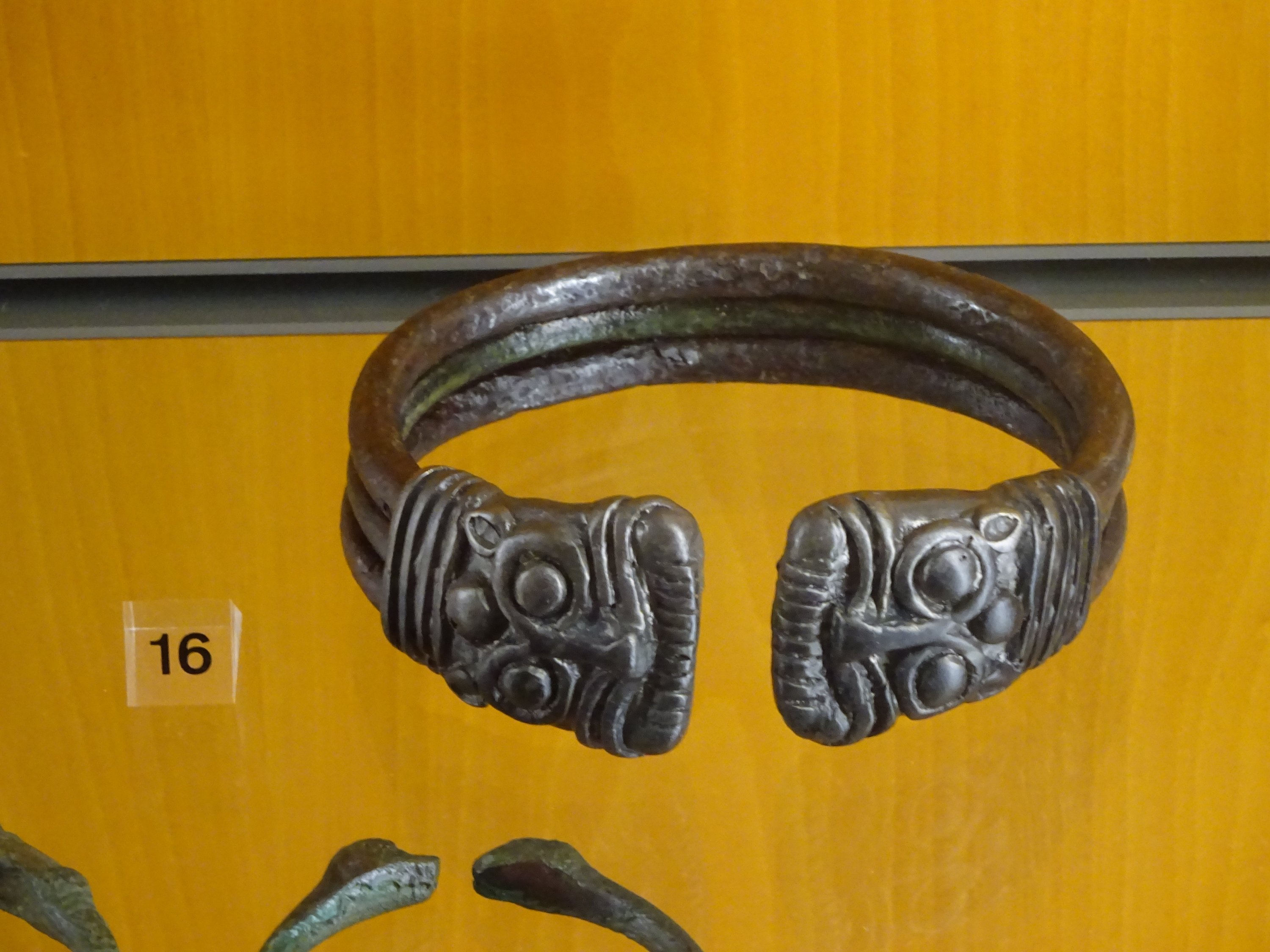
Before looking at the individual pieces, I quoted Ghirshman above to the effect that the Luristan bronzes are unique. What this means is that they are unique in style and also are at odds with the preceding artistic tradition of this area. This leads Ghirshman to speculate about who the makers of these bronzes could have been. As Ghirshman first published this book back in the 1950s, I assumed that this matter had subsequently been cleared up, but a recent piece in National Geographic surprisingly reveals that the provenance of the Luristan bronzes is as much a mystery today as it was in his time. Thus, Ghirshman’s speculations on it are still worth examining. He argues that:
“If we consider the rich and varied collection of bronzes and the variety of symbols which they portray, we may conclude that they must have belonged to an elite clan of warrior horsemen and charioteers, who were reluctant to settle on the land and for this reason valued portable goods. Objects from Luristan which are not portable are rare.”
He also notes that there is no evidence of settlement around the area of the tombs, once again pointing to the probability of them belonging to a nomadic horse-borne people. Ghirshman makes a compelling case. These small objects could easily be carried by a horse rider while, at the same time, their skilled artistic work would evince their high value and thus advertise their status. There is also the explicit connection of some of these objects to the needs of horse riding, such as the bit. There are also two implicit connections in the first object covered above. Obviously, this depicts a rider, albeit one creature riding another. But more than this, the shape of the thing itself, with its sleek lines and what could be described as the aerodynamic tilt of the head of the ibex, suggests movement at speed, a concept of paramount importance to nomadic riders. In the era before steam or motor engines, speed would be synonymous with the direction of animals such as the ibex or the horse. Indeed, we have carried this concept into modern times, with certain vehicles motor vehicles being given names such as Impala and Mustang.
Such considerations make it unlikely that the Luristan bronzes would have been made by the traditional local mountain peoples, whose pace of life, even into modern times, has been marked by the slow-moving footfalls of their flocks of sheep or goats. They are far more likely to have belonged to what Ghirshman calls a migratory “clan of warrior-horsemen.” Possible candidates for these horse-borne “Asiatic peoples” are given by Ghirshman as Scythians and Cimmerians, so it is possible that the Luristan bronzes have a link with peoples of Central Asian origin who themselves are ethnically linked with the Turks. Moreover, if the ibex in the first piece is indeed a Siberian one, this would increase the likelihood of Ghirshman’s potential identification.
As for my view of the Luristan bronzes, however, I have to say that save for the ibex mount of the rider, which is absolutely superb, and the minimalist horse bit that is possibly not even a Luristan bronze, I was not particularly taken with what was displayed here and was somewhat disappointed.
Mesopotamian seals
It seems that at least sometimes in life, though, where what is expected disappoints, what is unexpected compensates for it. This happened to me with the nearby display of cylinder seals.
I have long known of cylinder seals due to my interest in the Golden Age of archaeology, in which they were highly sought after. Originally, they were used by Mesopotamian peoples with their unique designs as a mark of ownership, much like a signature today. So I had long been aware of their purpose, yet it was in the museum in Lyon that, for the first time, I saw that they could also be exquisite works of art. That is not to say that the seals themselves are particularly eye-catching objects. Sometimes smaller than thimbles, they appear as cylindrical pieces of semi-precious stone with markings that are difficult to make out etched into them. In the museum, however, to display the images on the seals and thus reflect their use in ancient times, the cylinder seal has been rolled out onto a plaster-like material. This image is then displayed next to the seal itself and it is, of course, upon these images that the rest of this section is concerned.
The display of the cylinder seals in the Lyons Museum also reveals continuity. In modern times, and as can be witnessed in the shows in other parts of this museum, art movements rapidly overtake one another. Here, however, there is a continuity not only in cylinder seal use but, as will be seen, in imagery, too, across a period of approximately two thousand years. This reflects stability in the art of Mesopotamia, which should not be confused with stacticity. As the political history of this region witnesses the rise and fall of a number of different polities, this artistic continuity is all the more remarkable.
One cylinder seal [06] labeled “Master of Animals,” although it belongs to Old Akkadian dynasties and is dated to 2600-2340 B.C., would also not seem out of place in a Modern Art collection. The figure in the middle and the focus of the piece are elongated and stylized in a similar yet simpler manner to that of Ernst Ludwig Kirchner. All the same, the muscularity of this figure is very apparent. With his arms outstretched, he is restraining two rearing animals on either side, each side mirroring the other. Of the four animals, which also display Kirchner-like angularity, the outer animal must be a lion, as it has a mane and a long erect tail, and the inner animal may be the same. The image impresses the viewer with the force and vigor in the attack of the animals and the power the human figure exerts to restrain them.
Rather than being some lion tamer of the early Bronze Age, the figure presumably represents the human attempt to dominate and tame nature and thus render a world replete with potential natural threats more amenable to civilized life, Mesopotamia being the birthplace of civilization. Although the inception of the idea of humanity taking control of nature is often attributed to Francis Bacon – the 17th-century philosopher and not the 20th-century artist whose work can be found elsewhere in the museum – the concept is clearly expressed here many millennia before his work.
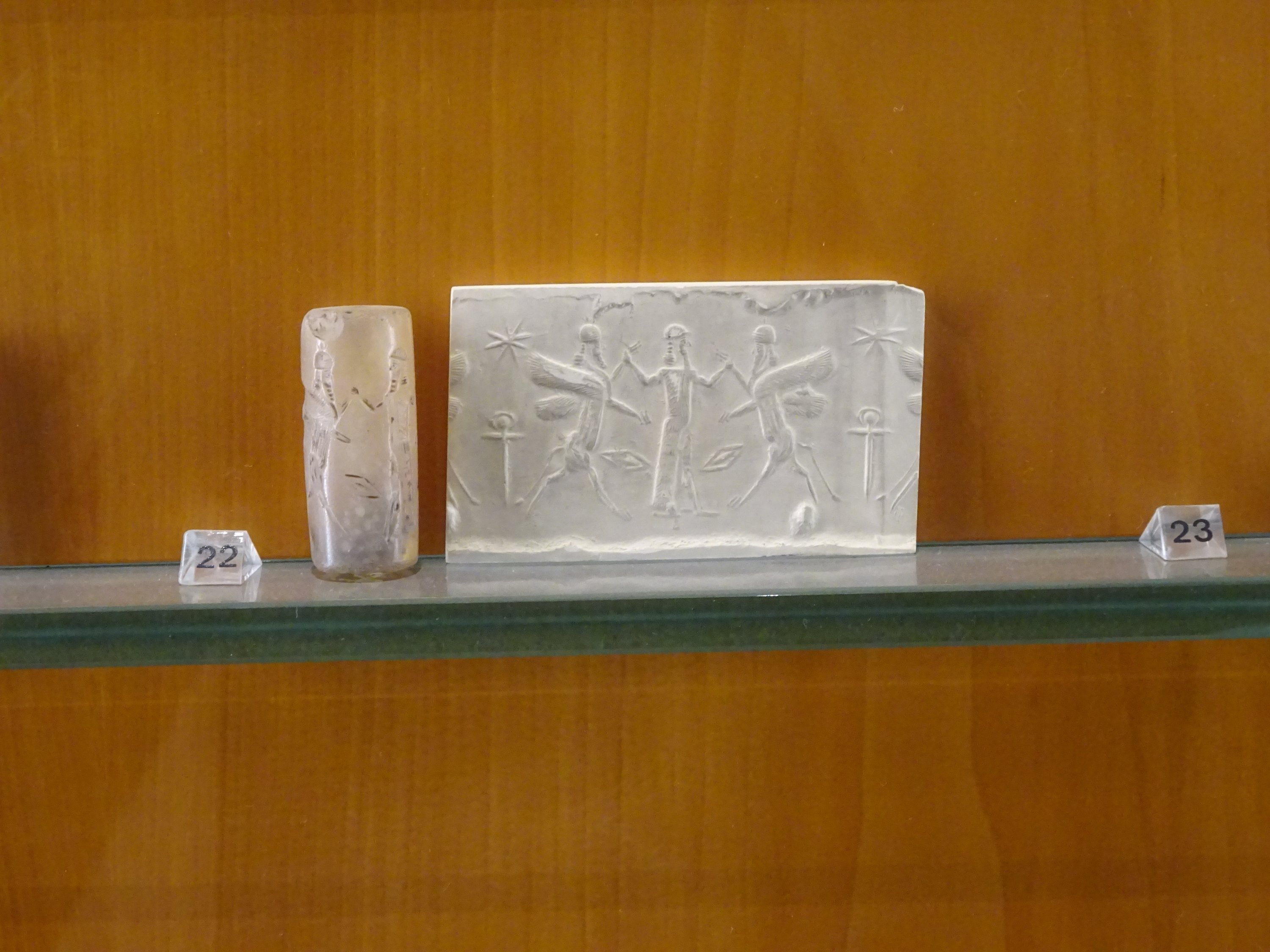
There is something of a stylistic change, in terms of greater detail, between this and another cylinder seal labeled “Hero confronting two winged male demons under the stars.” Yet, as this piece is much later, being Neo-Assyrian or Neo-Babylonian from the eighth or seventh century B.C., the elements of continuity are astonishing. Once again, there is a central figure exerting control over antagonistic figures symmetrically on both sides of him.
Here the demons attract the most attention; they are not exactly fear-inspiring, but their demonic nature is indicated by their wings and what a closer examination reveals to be their goatish legs and hips and long tails. The hero, unlike the modern superheroes who infest our cinemas with their anxieties and self-doubt, does not seem to have even broken a sweat in apprehending these two nefarious creatures. He stands tall and calm with his feet apart, grasping the demons by their forearms as if they were little more than locusts, which they somewhat resemble in shape if not in intended size.
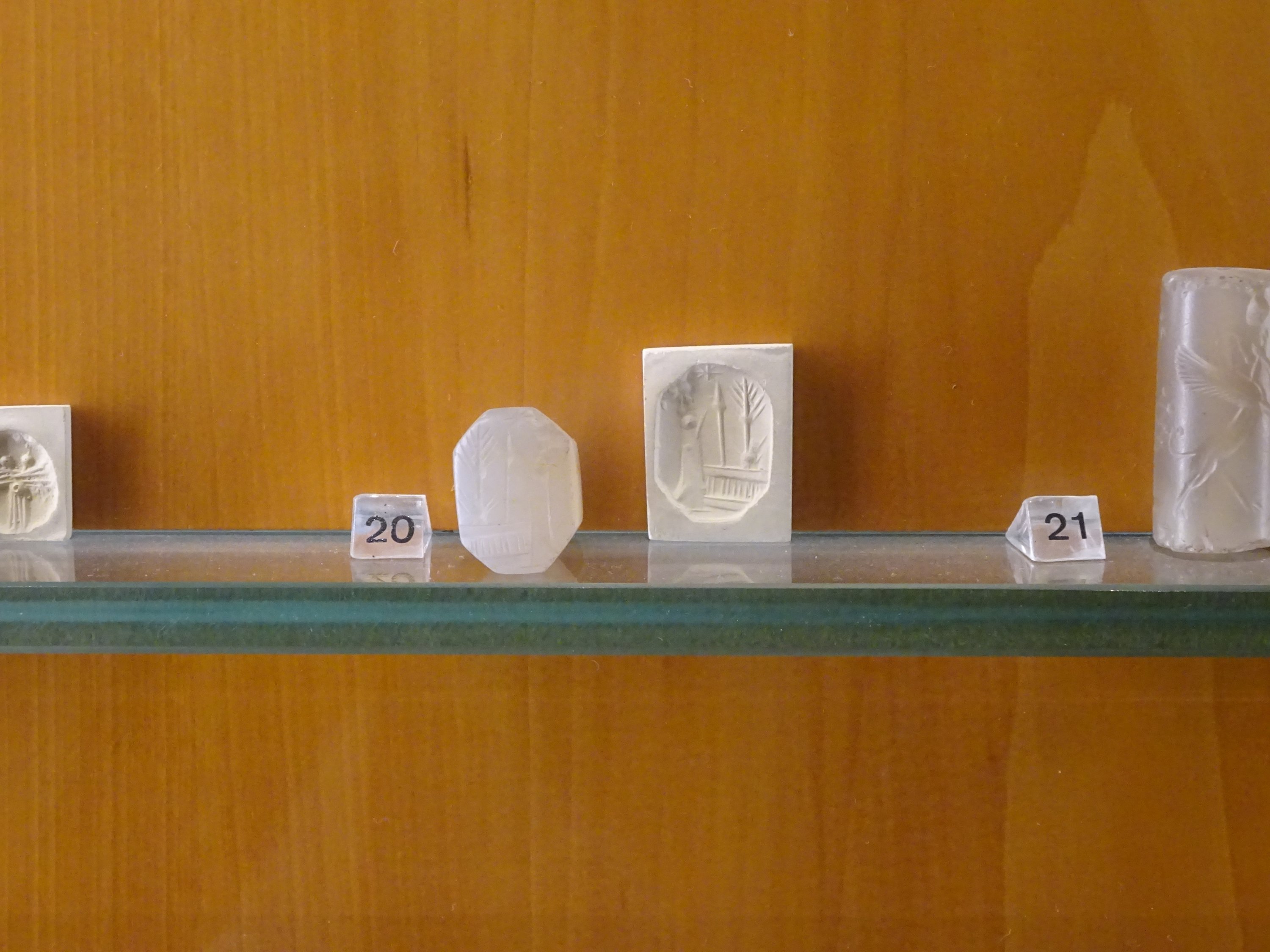
Not all Mesopotamian seals are cylinder seals, however. They also used the more straightforward pressing seal. Indeed, it has been argued that the cylinder seal developed out of this. There is one excellent seal impression on display in the museum. It is labeled as “Praying before an altar” and belongs to the Neo-Babylonian Empire, being dated to 600-400 B.C.
Although it is claimed that linear perspective in art is a Renaissance invention, it is clearly evident here with the side of the decorated altar. The worshipper who is raising his arm in prayer also plainly belongs to the middle distance, making it appear a three-dimensional image. As for its title, it must be correct. Yet, for me, the whole image strikingly resembles a robed Near Eastern man of today standing on his terrace at night, upon the wall of which is a hanging plant, while a star shines over the whole scene, illuminating the other side of the terrace railing a minaret and a palm tree.
In such a manner, this work seemingly links ancient Near Eastern art to the Islamic culture that now dominates the whole region. As for the art in this museum that specifically belongs to this later culture, I hope to soon produce a piece upon it.
Courtesy: Dailysabah

